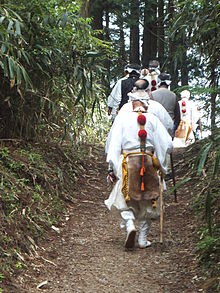User:Shenavall/sandbox3



Sources for stub article[edit]
Source (1) A book on the subject of Japanese folklore [1]
Source (2) A book on the subject of Tengu [2]
Source (3) A book on the subject of the origins of Japanese Martial Arts[3]
Source (4) A digitised manuscript [4]
Source (5) A NOH play 'story paper' [5]


IPA FOR USE IN LEAD NIHONGO TEMPLATE
IPA: [soːd͡ʑoːboː]
pronounced [soːd͡ʑoːboː]
Japanese: [soːd͡ʑoːboː]
Japanese pronunciation: [soːd͡ʑoːboː] The first two characters (僧正, sōjō) in the name mean 'Buddhist high priest' in Japanese.Sōjōbō (Japanese: 僧正坊, IPA: [soːd͡ʑoːboː], 'Buddhist high priest')
- ^ Davis, F. Hadland (1912). Myths & Legends of Japan. New York: T.Y. Crowell co. Retrieved 3 April 2020.
- ^ Hansen, Wilburn N. (2008). When Tengu Talk: Hirata Atsutane’s Ethnography of the Other World. Honolulu: University of Hawaii Press.
- ^ Knutsen, Ronald (2011). Tengu : the Shamanic and Esoteric Origins of the Japanese Martial Arts. Folkestone: Global Oriental.
- ^ "Or 13839". Digitised Manuscripts. British Library. Retrieved 3 April 2020.
- ^ "Kurama-tengu (Long-nosed Goblin in Kurama)". Plays Database. the-Noh.com. Retrieved 3 April 2020.
- ^ Buswell, Robert E. (2014). The Princeton Dictionary of Buddhism. Princeton: Princeton University Press. p. 812. doi:10.2307/j.ctt46n41q. ISBN 978-0-691-15786-3.
